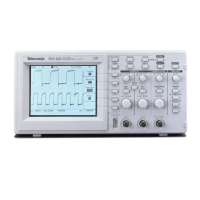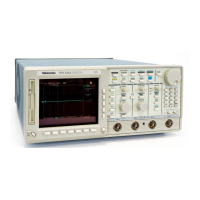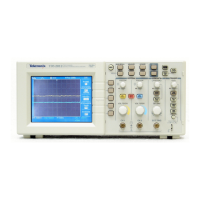1Ć4
The triggering system supports a varied set of features for triggering the
signalĆacquisition system. Trigger signals recognized include:
H (mainĆ and delayedĆtrigger systems): This familiar type of triggerĆ
ing is fully configurable for source, slope, coupling, mode (auto or
normal), and holdoff.
H (mainĆtrigger system): This type of triggering can be based on
pattern (asynchronous) or state (synchronous). In either case, logic
triggering is configurable for sources, for boolean operators to apply to
those sources, for logic pattern or state on which to trigger, for mode
(auto or normal), and for holdoff. Time qualification may be selected in
pattern mode.
H (mainĆtrigger system): Pulse triggering is configurable for triggerĆ
ing on runt or glitch pulses, or on pulse widths or periods inside or
outside limits that you specify. It is also configurable for source, polarity,
mode, and holdoff.
H (with option 05: Video Trigger): Video triggering is compatible with
standard NTSC, PAL, SECAM, and HDTV formats. An additional feature
called FlexFormat
TM
(flexible format) allows the user to define the video
format on which to trigger.
You can choose where the trigger point is located within the acquired waveĆ
form record by selecting the amount of pretrigger data displayed. Presets of
20%, 50%, and 80% of pretrigger data can be selected in the horizontal
menu, or the general purpose knob can be assigned to set pretrigger data
to any value within the 20% to 80% limits.
You can specify a mode and manner to acquire and process signals that
matches your measurement requirements.
H Select the mode for interpolation of points sampled on nonĆrepetitive
signals (linear or sin (x)/x. This can increase the apparent sample rate
on the waveform when maximum realĆtime rates are reached.
H Use sample, envelope, and average modes to acquire signals.
H Set the acquisition to stop after a single acquisition (or sequence of
acquisitions if acquiring in average or envelope modes), or after a limit
condition has been met.
H Select channel sources for compliance with limit tests. You can direct
the TDS to signal you or generate hard copy output either to a printer or
to a floppy disk (with option 1F) based on the results. Also, you can
create templates for use in limit tests.

